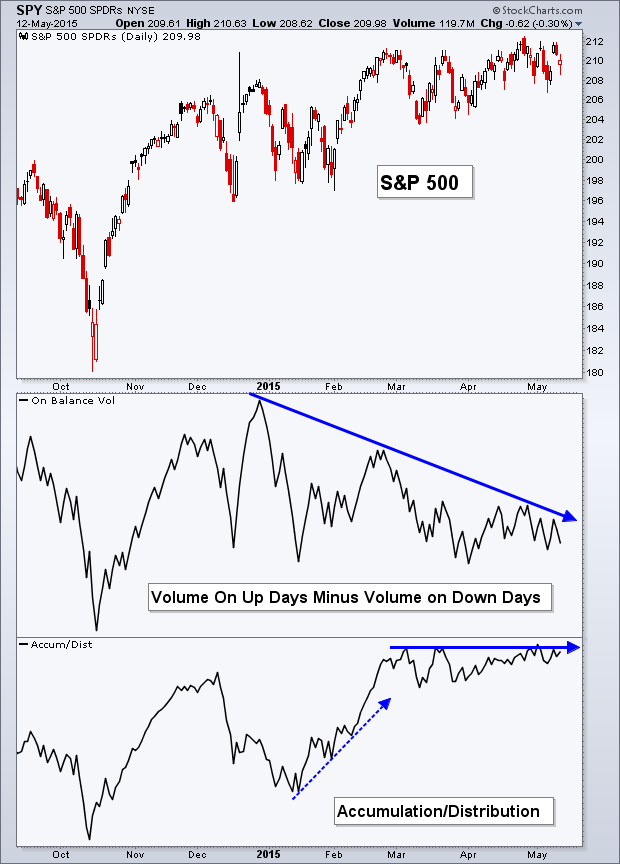The last post I wrote took long-term look at the S&P 500 from a monthly viewpoint. Today I want to look at the S&P 500 SPDR ETF (ARCA:SPY) on a daily chart but focus on volume and what that has to say about the current trend.
I’m using the S&P ETF rather than the index itself to get a ‘truer’ view of volume flow. There are two indicators I want to look at when analyzing volume: On Balance Volume (OBV) and Accumulation/Distribution. Both of these tools take into account the raw amount of shares traded but the way the amount is used is different for each tool.
Let’s first look at On Balance Volume. This indicator simply adds the number of shares traded when SPY is positive for the day and subtracts the number of shares traded when the ETF has negative performance for a day. This helps us see if there is more volume being traded on up or down days. When SPY is being bid higher, we’d prefer to see more activity and on down days see fewer shares traded. Now of course this doesn’t necessarily mean there are more or fewer traders involved on each of these days, as one person can buy 100,000 shares and it would have the same impact to volume as 100 investors trading 1,000 shares. But it’s accessing the amount of activity that volume can help us see.
Currently, for 2015, we are seeing a larger number of shares changing hands on down days than up days, as On Balance Volume has been declining since its late-December peak. This is creating a negative divergence with price as SPY has been advancing (albeit at a choppy pace) for the bulk of the last four months.

Next we have the Accumulation/Distribution indicator. Like OBV, the Accum/Dist tool uses volume in its measurement. However the difference is it doesn’t simply add and subtract volume based on if price finishes higher or lower on the day. Instead, this volume indicator looks at the range in which price traded that day and whether it closed in the higher or lower end of that range. At the start of this year we had a series of decent amounts of volume being traded with the close on SPY, as it sat at the top of the daily range. This pushed the Accumulation/Distribution indicator higher through January and February. However, since March it’s leveled out – similar to what’s taken place in price.
So what does all this have to say about volume and whether it supports the current price action in the equity market? I think we currently have a mixed bag. On the surface we have less trading activity on up days for the S&P 500 (SPY) than on down days, as shown by the OBV indicator, but at the same time price has been able to stabilize itself intraday and close near the higher end of its range, as shown in the Accum/Dist data.
At a quick glance, 2011 appears to have displayed a similar type of movement, with more shares traded on down days going into the intra-year peak in May. We’ll see if the bearish action in price that took place in 2011 repeats itself during this year. Just because volume diverged in 2011 doesn’t mean we'll see a near-bear market in 2015. I”ll be watching price more closely for signs of distress.
Disclaimer: Do not construe anything written in this post or this blog in its entirety as a recommendation, research, or an offer to buy or sell any securities. Everything in this post is meant for educational and entertainment purposes only. I or my affiliates may hold positions in securities mentioned in the blog. Please see my Disclosure page for full disclaimer.
